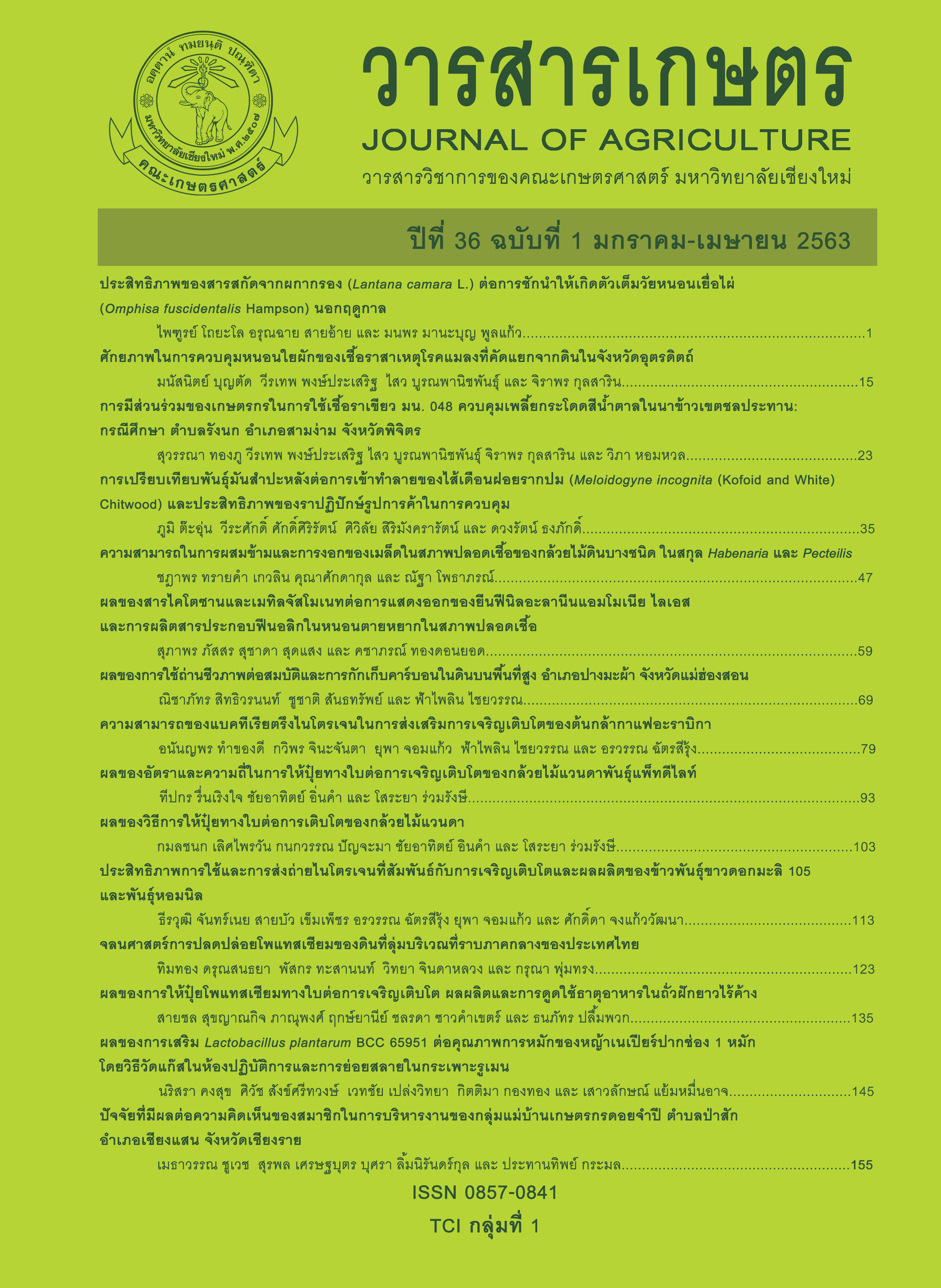ผลของการเสริม <I>Lactobacillus plantarum</I> BCC 65951 ต่อคุณภาพการหมักของหญ้าเนเปียร์ปากช่อง 1 หมัก โดยวิธีวัดแก๊สในห้องปฏิบัติการและการย่อยสลายในกระเพาะรูเมน
Main Article Content
บทคัดย่อ
วัตถุประสงค์ของการศึกษาในครั้งนี้เพื่อศึกษาคุณภาพการหมัก องค์ประกอบทางเคมีและการย่อยสลายในกระเพาะรูเมนของหญ้าเนเปียร์ปากช่อง 1 ที่เสริมและไม่เสริม Lactobacillus plantarum BCC 65951 โดยทำการตัดหญ้าเนเปียร์ปากช่อง 1 ที่อายุ 45 วัน แบ่งออกเป็น 2 กลุ่มทดลอง คือ กลุ่มที่ 1 หญ้าเนเปียร์ปากช่อง 1 หมักแบบไม่เติม L. plantarum BCC 65951 (control) และกลุ่มที่ 2 หญ้าเนเปียร์ปากช่อง 1 หมักแบบเติม L. plantarum BCC 65951 ในปริมาณ 107CFU ต่อกรัมหญ้าสด (LAB) เมื่อหญ้าหมักมีระยะการหมักได้ 21 วัน นำหญ้าหมักที่ได้มาวิเคราะห์คุณภาพการหมัก องค์ประกอบทางเคมีโดยวิธี Proximate analysis และวิเคราะห์เยื่อใยโดยวิธี Detergent fiber method และวิเคราะห์การย่อยสลายในกระเพาะรูเมนโดยวิธี in vitro gas production technique โดยใช้ของเหลวจากกระเพาะรูเมนของโคพื้นเมืองเจาะกระเพาะเพศผู้ จำนวน 4 ตัว โดยบ่มตัวอย่างเป็นเวลา 2, 4, 8, 10,12, 24, 48, 72 และ 96 ชั่วโมง จากการศึกษาคุณภาพการหมัก พบว่า ปริมาณกรดแลกติก กรดอะซิติก กรดโพรพิโอนิกและแอมโมเนีย-ไนโตรเจนของ LAB สูงกว่า control อย่างมีนัยสำคัญทางสถิติ (P<0.001) จากค่าองค์ประกอบทางเคมีของหญ้าเนเปียร์ปากช่อง 1 หมัก พบว่า ปริมาณวัตถุแห้งของ control มีค่าสูงกว่า LAB อย่างมีนัยสำคัญทางสถิติ (P<0.05) นอกจากนี้ปริมาณแก๊สสุทธิที่เกิดขึ้นในชั่วโมงที่ 2 ของ LAB สูงกว่า control (P<0.05) อย่างไรก็ตามปริมาณจุลินทรีย์ที่เกิดจาการหมัก ค่าพลังงานใช้ประโยชน์ได้ การย่อยได้ของอินทรียวัตถุ และปริมาณกรดไขมันระเหยได้ไม่มีความแตกต่างกันทางสถิติ (P>0.05) โดยการศึกษาครั้งนี้สรุปได้ว่าการใช้ L. plantarum BCC 65951 ในหญ้าเนเปียร์ปากช่อง 1 หมัก ทำให้มีปริมาณวัตถุแห้งลดลง และยังส่งผลให้หญ้าหมักมีกรดแลกติก กรดอะซิติก กรดโพรพิโอนิก และแอมโมเนีย-ไนโตรเจนสูง อีกทั้งยังมีการย่อยสลายในกระเพราะรูเมนช่วง 2 ชั่วโมงแรกได้ดีกว่าอีกด้วย
Article Details
References
Adesoji, A.T., A.A. Ogunjobi, O.E. Fagade and O.J. Babayemi. 2010. Effect of Lactobacillus plantarum starter culture on the microbial succession, chemical composition, aerobic stability and acceptability by ruminant of fermented Panicum maximum grass. Assumption University Journal of Technology 14(1): 11-24.
AOAC. 2000. Official Methods of Analysis of AOAC International. 17th ed. AOAC International, Gaithersburg, Maryland.
Arasu, M.V., M.W. Jung, D.H. Kim, S. Ilavenil, M. Jane, H.S. Park, N.A. Al-Dhabi, B.T. Jeon and K.C. Choi. 2014. Enhancing nutritional quality of silage by fermentation with Lactobacillus plantarum. Indian Journal of Microbiology 54(4):396-402.
Bal, M.A., J.G. Coors and R.D. Shaver. 1997. Impact of the maturity of corn for use as silage of dairy cows on intake, digestion and milk production. Journal of Dairy Science 80(18): 2497-2503.
Basso, F.C. 2013. Corn silage inoculated with microbial additives. Ph.D. Thesis. Universidade Estadual Paulista, Campus de Jaboticabal, Sao Paulo. 81 p.
Blümmel, M., H.P.S. Makkar and K. Becker. 1997. In vitro gas production: a technique revisited. Journal of Animal Physiology and Animal Nutrition 77(1-5): 24-34.
Chen L., G. Guo, X. Yuan, J. Zhang, J. Li and T. Shao. 2016. Effects of applying molasses, lactic acid bacteria and propionic acid on fermentation quality, aerobic stability and in vitro gas production of total mixed ration silage prepared with oat-common vetch intercrop on the Tibetan Plateau. Journal of the Science of Food and Agriculture 96(5): 1678-1685.
Chen, J., M.R. Stokes and C.R. Wallace. 1994. Effects of enzyme-inoculant systems on preservation and nutritive value of haycrop and corn silages. Journal of Dairy Science 77(2): 501-512.
Contreras-Govea, F.E., R.E. Muck, G.A. Broderick and P.J. Weimer. 2013. Lactobacillus plantarum effects on silage fermentation and in vitro microbial yield. Animal Feed Science and Technology 179: 61-68.
Fellner, V., L.E. Phillip, S. Sebastian and E.S. Idziak. 2001. Effects of a bacterial inoculant and propionic acid on preservation of high-moisture ear corn, and on rumen fermentation, digestion and growth performance of beef cattle. Canadian Journal of Animal Science 81(2): 273-280.
Ferreira, D.d.J., R.d.P. Lana, A.d.M. Zanine, E.M. Santos, C.M. Veloso and G.A. Ribeiro. 2013. Silage fermentation and chemical composition of elephant grassinoculated with rumen strains of Streptococcus bovis. Animal Feed Science and Technology 183: 22-28.
Hoffman, P.C. and S.M. Ocker. 1997. Quantification of milk yield losses associated with feeding aerobically unstable high moisture corn. Journal of Dairy Science 80(Suppl. 1): 234. (abstract)
Martínez-Campos, R. and M. de la Torre. 2002. Production of propionate by fed-batch fermentation of Propionibacterium acidipropionici using mixed feed of lactate and glucose. Biotechnology Letters 24(6): 427-431.
Mayr-Harting, A., A.J. Hedges and R.C.W. Berkeley. 1972. Method for studying bacteriocins. pp. 315-422. In: J.R. Norris and D.W. Ribbons (eds.). Methods in Microbiology. Academic Press, Inc., London.
McDonald, P., A.R. Henderson and S.J.E. Heron. 1991. The Biochemistry of Silage. 2nd ed. Chalcombe Publications, Marlow, Bucks.
Menke, K.H. and H. Steingass. 1988. Estimation of the energetic feed value obtained from chemical analysis and in vitro gas production using rumen fluid. Animal Research and Development 28: 7-55.
Menke, K.H., L. Raab, A. Salewski, H. Steingass, D. Fritz and W. Schneider. 1979. The estimation of the digestibility and metabolizable energy content of ruminant feedingstuffs from the gas production when they are incubated with rumen liquor in vitro. The Journal of Agricultural Science 93(1): 217-222.
Ni, K.K., Y.P. Wang, H.L. Pang and Y.M. Cai. 2014. Effect of cellulase and lactic acid bacteria on fermentation quality and chemical composition of wheat straw silage. American Journal of Plant Sciences 5: 1877-1884.
Phiri, M.S., N.T. SNgongoni, B.V. Maasdorp, M. Titterton, J.F Mupangwa and A. Sebata. 2007. Ensiling characteristics and feeding value of silage made from browse tree legume-maize mixtures. Tropical and Subtropical Agroecosystems 7(3): 149-156.
Steel, R.G.D. and J.H. Torrie. 1980. Principles and Procedures of Statistics, A Biometrical Approach. 2nd ed. McGraw-Hill Book Company, New York.
Van Soest, P.J., J.B. Robertson and B.A. Lewis, 1991. Methods for dietary fiber, neutral detergent fiber, and nonstarch polysaccharides in relation to animal nutrition. Journal of Dairy Science 74(11): 3583-3597.
Weinberg, Z.G., G. Ashbell, A. Azrieli and I. Brukental. 1993. Ensiling peas, ryegrass and wheat with additives of lactic acid bacteria (LAB) and cell wall degrading enzymes. Grass and Forage Science 48(1): 70-78.
Whitlock, M.C., P.K. Ingvarsson and T. Hatfield. 2000. Local drift load and the heterosis of interconnected populations. Heredity 84(4): 452-457.
Yammuen-art, S., P. Somrak and C. Phatsara. 2016. Effect of maize cob and husk ratio in napier Pakchong 1 silage on nutritive value and in vitro gas production in rumen fluid of Thai native cattle. Animal Production Science 57(8): 1603-1606.
Yuan, X., G. Guo, A. Wen, S.T. Desta, J. Wang, Y. Wang and T. Shao. 2015. The effect of different additives on the fermentation quality, in vitro digestibility and aerobic stability of a total mixed ration silage. Animal Feed Science and Technology 207: 41-50.

